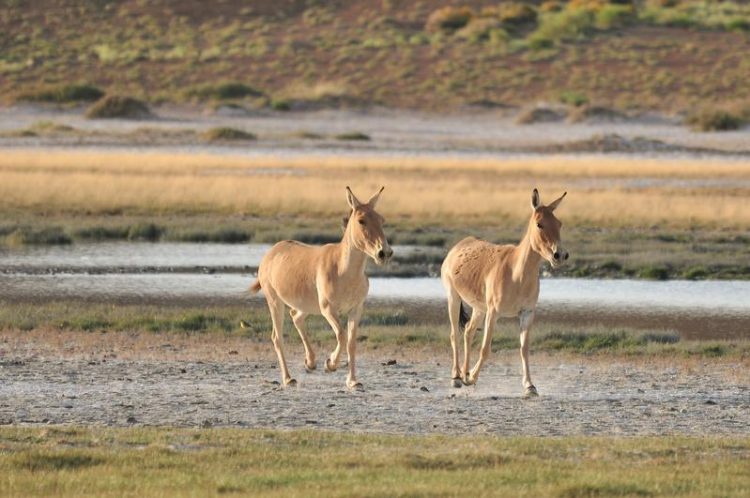Hidden treasure of the Gobi: How khulans get water

Khulans at waterpoint P. Kaczensky
Most large herbivores in arid landscapes are especially vulnerable to disturbances of their habitat – one of these is the Asiatic wild ass or khulan (Equus hemionus). Until recently widespread and abundant throughout the arid landscapes of Central Asia and Mongolia, the number of khulan has declined dramatically in the 19th and 20th century.
Besides changes in land use and overhunting, the increasing difficulty in accessing water is believed to have played a major role in this development. Until now, however, there had been little data on how water availability is influencing movements.
Waterpoints constitute a key resource for khulan
To find out more about khulan water use, an international research team led by the Research Institute for Wildlife Ecology (FIWI) at the Department of Interdisciplinary Life Sciences at Vetmeduni Vienna examined the world’s largest remaining khulan population in Mongolia’s South Gobi Region.
By tagging the khulan with GPS collars in order to track the animals in the 100,000 km² study area, an area larger than Austria, the researchers were able to identify 367 waterpoints, 53 of which received intensive and repeated uses by many different kulan over multiple years and are thus considered to be of high importance for the entire khulan population.
However, the large number of less visited waterpoints are also important as they provide “stepping-stones” to switch between areas and allow for maximal movement flexibility.
The need to drink daily is an important driver of khulan movements
According to the researchers, khulan drink almost daily and normally require 12–15 litres of water per day and up to 24 litres on hot days. The low water content of their plant resources further increases the animals’ need to drink. In the Mongolian Gobi, khulan roam over thousands of square kilometres, a range among the largest reported for terrestrial mammals.
These large nomadic movements are a consequence of the low and unpredictable resource base with both the availability of pasture and water changing within and between years. To survive and thrive in such landscapes, movement flexibility is key but may be threatened by increasing human impact on the khulan’s habitat resulting in habitat fragmentation.
Like in many other of the world’s drylands, human exploitation of water for agriculture, industry, and domestic uses increasingly drives the availability of and access to water for wildlife. Khulan tend to use pastures within 7 km of water and areas beyond 15-20 km of water become functionally inaccessible.
“Hence, blocking access to water excludes khulan from the landscape and Identifying important waterpoints in arid landscapes like the Gobi Desert is therefore essential for wildlife-friendly land-use planning,” says John Payne.
Important data for a regional khulan conservation strategy
According to the researchers, the most important variable for the seasonally different use of the waterpoints is snow cover (or the lack thereof). In the deserts of Central Asia and Mongolia, a lack of snow, the low water content of the vegetation, and the freezing of small and stagnant water bodies can result in drought conditions during winter. In extreme cases, these factors can result in winter die-offs of local wildlife populations.
Khulan´s highly mobile lifestyle is a coping strategy during localized catastrophic weather events, but this requires habitats that allow large-scale movements – which in turn necessitates maintaining landscape connectivity.
Petra Kaczensky: “Our results provide important data that can help guide a regional khulan conservation strategy, allow predictions for other khulan populations, and illustrate the overall importance of waterpoints for dryland herbivores.”
###
Service:
The article “Hidden treasure of the Gobi: understanding how water limits range use of khulan in the Mongolian Gobi” by John Payne, Bayarbaatar Buuveibaatar, Diana Bowler, Kirk Olson, Chris Walzer, and Petra Kaczensky was published in Scientific Reports.
https://www.nature.com/articles/s41598-020-59969-2?proof=true19
About the University of Veterinary Medicine, Vienna:
The University of Veterinary Medicine, Vienna in Austria is one of the leading academic and research institutions in the field of Veterinary Sciences in Europe. About 1,300 employees and 2,300 students work on the campus in the north of Vienna which also houses five university clinics and various research sites. Outside of Vienna the university operates Teaching and Research Farms. The Vetmeduni Vienna plays in the global top league: in 2019, it occupies the excellent place 5 in the world-wide Shanghai University veterinary in the subject “Veterinary Science”. http://www.vetmeduni.ac.at
Petra Kaczensky
Norwegian Institute for Nature Research – NINA &
Research Institute of Wildlife Ecology
Vetmeduni Vienna
T +47 92232-560
petra.kaczensky@nina.no
The article “Hidden treasure of the Gobi: understanding how water limits range use of khulan in the Mongolian Gobi” by John Payne, Bayarbaatar Buuveibaatar, Diana Bowler, Kirk Olson, Chris Walzer, and Petra Kaczensky was published in Scientific Reports.
https://www.nature.com/articles/s41598-020-59969-2?proof=true19
https://www.vetmeduni.ac.at/en/infoservice/press-releases/press-releases-2020/hi…
Media Contact
All latest news from the category: Life Sciences and Chemistry
Articles and reports from the Life Sciences and chemistry area deal with applied and basic research into modern biology, chemistry and human medicine.
Valuable information can be found on a range of life sciences fields including bacteriology, biochemistry, bionics, bioinformatics, biophysics, biotechnology, genetics, geobotany, human biology, marine biology, microbiology, molecular biology, cellular biology, zoology, bioinorganic chemistry, microchemistry and environmental chemistry.
Newest articles

First-of-its-kind study uses remote sensing to monitor plastic debris in rivers and lakes
Remote sensing creates a cost-effective solution to monitoring plastic pollution. A first-of-its-kind study from researchers at the University of Minnesota Twin Cities shows how remote sensing can help monitor and…

Laser-based artificial neuron mimics nerve cell functions at lightning speed
With a processing speed a billion times faster than nature, chip-based laser neuron could help advance AI tasks such as pattern recognition and sequence prediction. Researchers have developed a laser-based…

Optimising the processing of plastic waste
Just one look in the yellow bin reveals a colourful jumble of different types of plastic. However, the purer and more uniform plastic waste is, the easier it is to…



